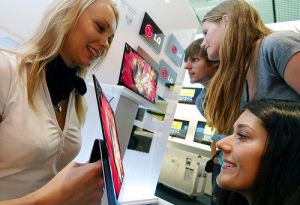 Yesterday we reported on the DOE's Recover Act Rewards, and today we have more details on two of the projects. UDC got $4 million (out of a $8.3 million project) to create a US phosphorescent OLED Lighting panel manufacturing Facility. UDC will design and setup two pilot lines, and will provide prototype lighting panels to U.S. luminaire manufacturers to incorporate into products, to facilitate testing of design, and to gauge customer acceptance.
Yesterday we reported on the DOE's Recover Act Rewards, and today we have more details on two of the projects. UDC got $4 million (out of a $8.3 million project) to create a US phosphorescent OLED Lighting panel manufacturing Facility. UDC will design and setup two pilot lines, and will provide prototype lighting panels to U.S. luminaire manufacturers to incorporate into products, to facilitate testing of design, and to gauge customer acceptance.
Moser Baer Technologies will supply equipment for these lines. The first might become operational already in 2011 (the specific location isn't public yet). The second line is geared towards commercial volumes of panels. This could mean that UDC will become an OLED panel production company - and not just an IP one. This is an interesting move by UDC that is quite risky as they will compete with their licensees.
UDC will also work with PPG Industries on another project titled "Low-Cost Integrated Substrate for OLED Lighting". PPG plans to develop the OLED lighting integrated substrate using low-cost soda lime float glass plus transparent anode materials and light extraction layers.
 We already know that GE plans to start printing OLED Lighting panels in 2010. Now Anil Duggal, GE's OLED lighting printing group leader, says that they know that those pilot panels will be very expensive. He hopes that by 2015, it'll be possible to print OLED panels that will be both cheap and efficient.
We already know that GE plans to start printing OLED Lighting panels in 2010. Now Anil Duggal, GE's OLED lighting printing group leader, says that they know that those pilot panels will be very expensive. He hopes that by 2015, it'll be possible to print OLED panels that will be both cheap and efficient.





